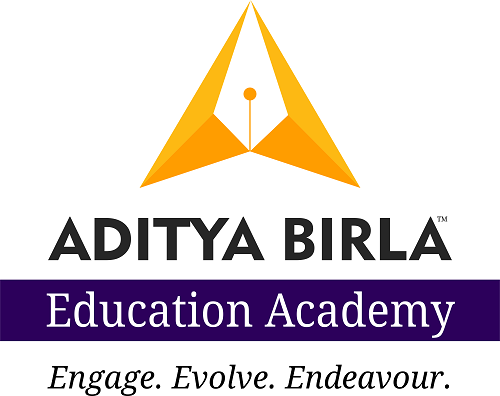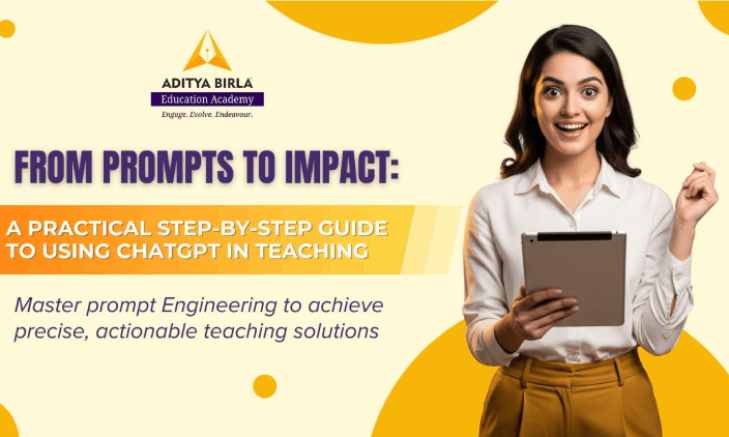So here's the question: are you really using ChatGPT the way it's meant to be used? It's been seen that lots of teachers are trying it here and there, but most of us are only scratching the surface.
Well, Aditya Birla Education Academy (ABEA) has spent years working side by side with teachers from different parts of India and even beyond. Adopting modern teaching methods to trying out AI tools, and other innovative strategies really help educators to handle their classroom better.
This blog brings together practical tips and strategies that many educators trained at ABEA are already using effectively - and you can start applying them too. It is designed to give you practical, classroom-ready strategies that many educators, trained by ABEA, already use successfully.
It's not about luck or who's "techy". It's about building a habit around how you prompt it. When you get that right, ChatGPT stops being a quick time-saver and actually feels like a co-teacher that helps with planning, feedback, and even parent emails without replacing your judgment.
Index of Content:
- Why This Matters Right Now
- What Is Prompt Engineering? (The Human-Friendly Way)
- The CLEAR Framework (A Real Time-Saver)
- The 5 Ingredients of a Killer Prompt
- Real Prompts That Actually Work
- Step-by-Step Manager: From "Nice Outputs" to "Real Classroom Wins"
- Common Failures (And Fast Fixes)
- Differentiation in 10 Minutes
- Assessment and Feedback: Fast and Personalized
- Communication That Builds Trust
- Make It Stick: Your Reusable Prompt Library
- Try This 7-Day Challenge
- Bonus: Copy-and-Use Prompt Pack
- Final Thought
How to Log In, Sign Up, and Start Using ChatGPT?
Step 1: Visit the Website
Go to chat.openai.com. Bookmark it, this will become a frequent stop once it saves you hours each week.
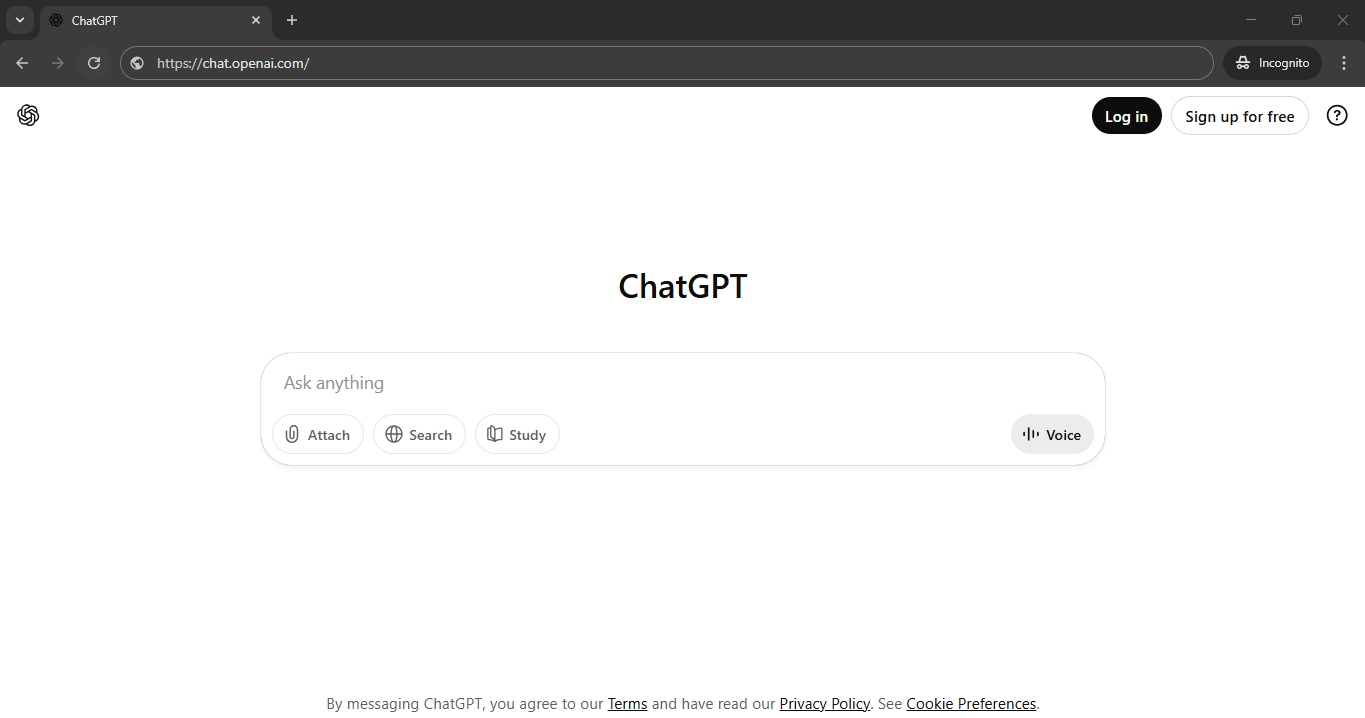
Step 2: Create an Account (First-Time Users Only)
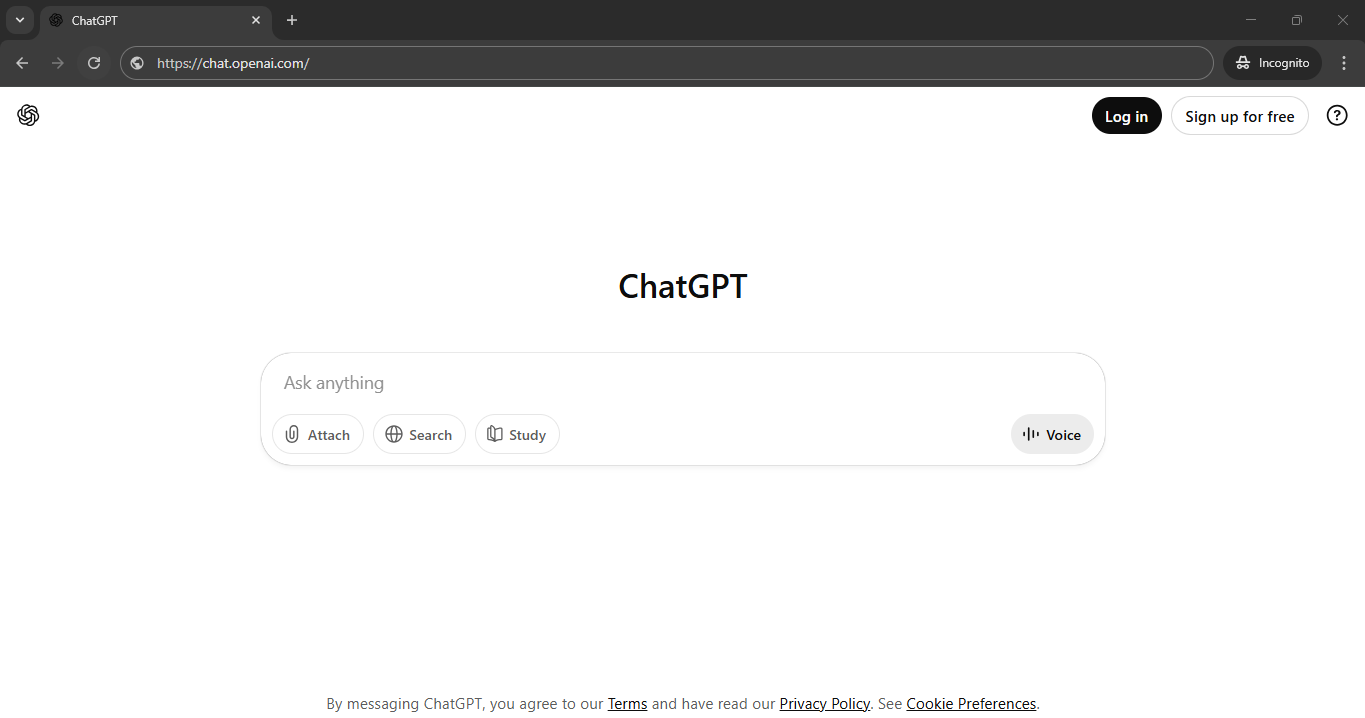
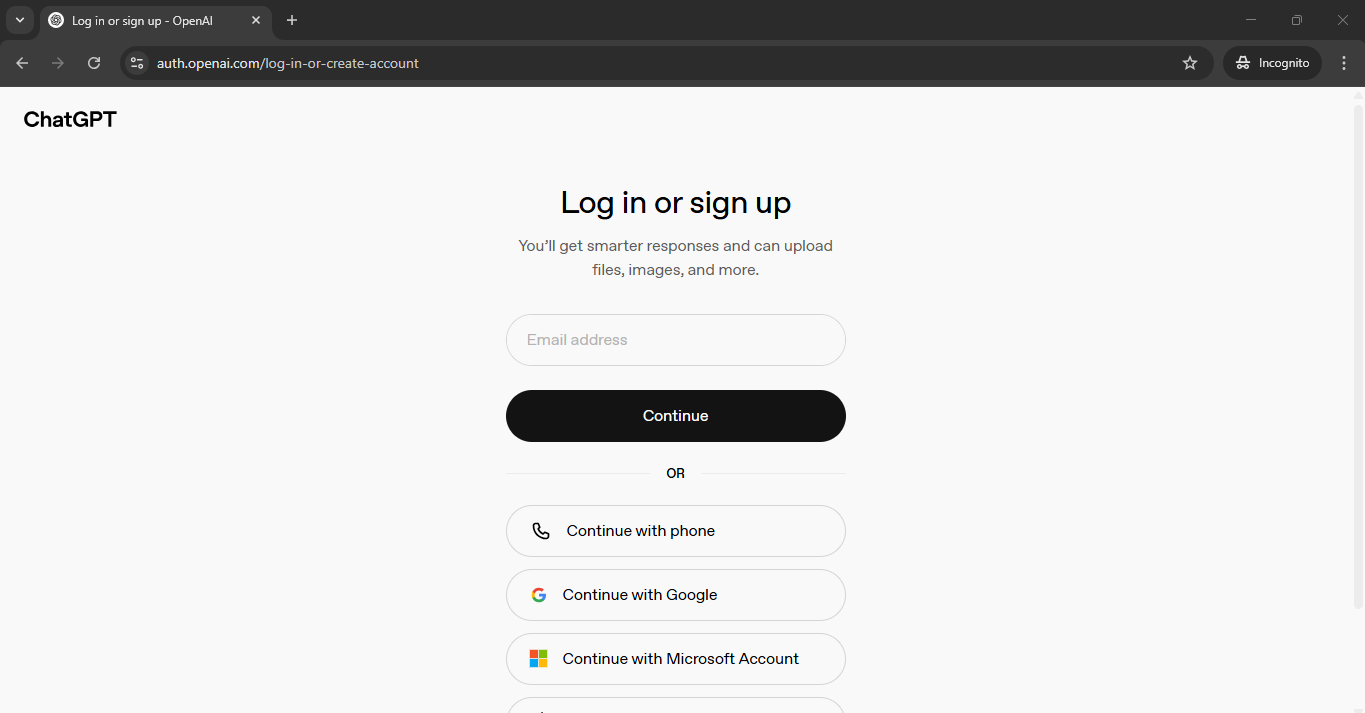
Click Sign Up.
Use your Google account, Microsoft account, or any email ID.
Confirm your email address and enter your name.
You may be asked to verify with your mobile number (one-time).
Result: You have an account. It takes under a couple of minutes.
Step 3: Log In (Returning Users)
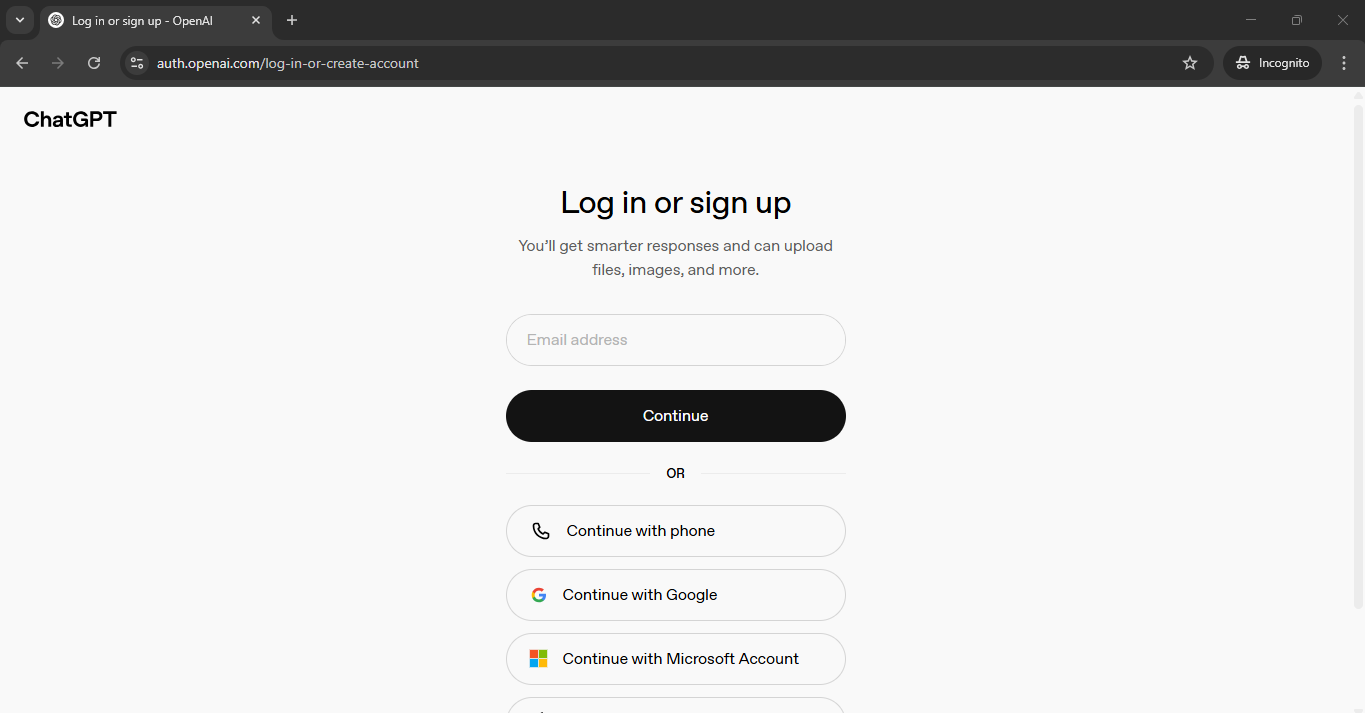
Go to the same site.
Click Log In.
Enter your credentials -> You're inside.
Step 4: Choose Free or Plus Plan
The free plan gives you the standard model (still powerful for teaching tasks).
ChatGPT Plus (paid) offers GPT - 5, faster speed, and priority access with 3X token limit than free plan.
Start free. Upgrade only if you notice heavy classroom use.
Step 5: Start Prompting
In the big text box at the bottom, type your first instruction.
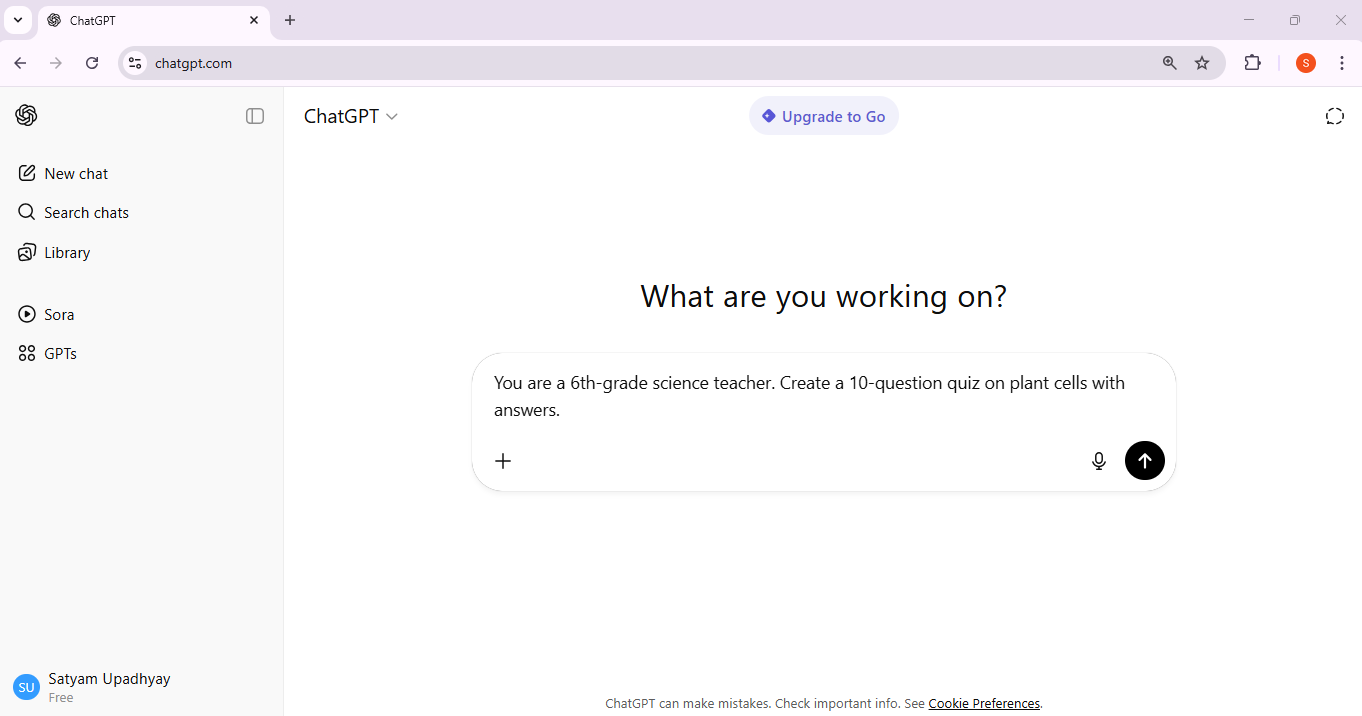
Example starter: "You are a 6th-grade science teacher. Create a 10-question quiz on plant cells with answers".
Hit Enter.
Result:
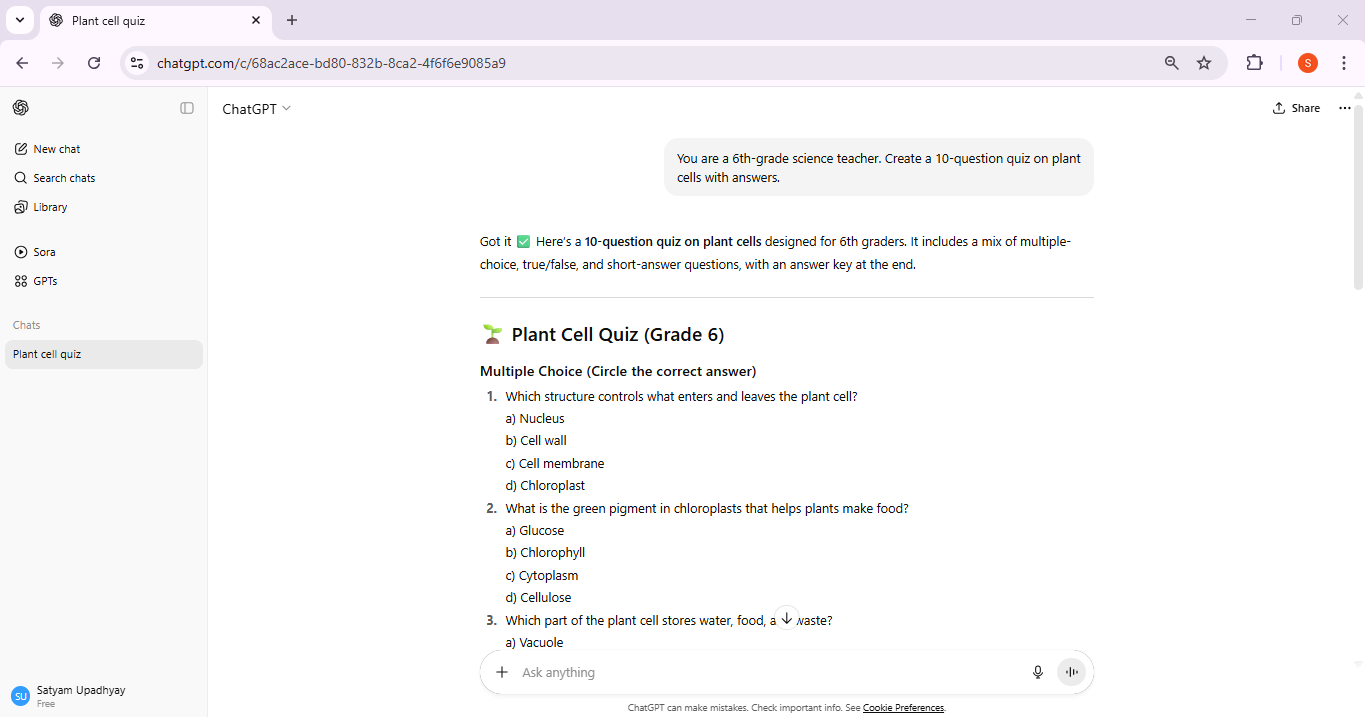
Upcoming Opportunity: If you want to master AI tools for teaching, don't miss ABEA's Certification Program on AI for Educators.
Register now to get notified when enrollment opens and be among the first to access structured, classroom-focused AI training.
Why Does Using ChatGPT in Teaching Matter Right Now?
If you've been teaching for a while, you already know the job doesn’t slow down after the bell. The grading pile waits, the lesson plans wait, parents are pinging you, and then there’s meeting after meeting. It just doesn’t end.
AI obviously can't connect with kids the way you do, but it can carry some of that background load. Teachers we’ve talked to say it saves them hours—literally hours—when they use clear prompts instead of just typing random questions into the box. A quiz in minutes, a rubric in minutes, even a parent email in minutes. That’s where Prompt Engineering comes in. And no, it’s not about learning some complicated tech skill. It’s just about learning how to communicate with the tool so it actually listens.
What Is Prompt Engineering? (The Human-Friendly Way)
Forget the jargon. Prompt engineering is simply giving better instructions. Vague inputs produce generic outputs. Specific, classroom-grounded inputs produce tailored, usable materials. You need to treat ChatGPT like a student-teacher intern: set the role, define the context, specify the task and format, and state constraints. Then iterate once or twice to secure quality. Now, let's understand with examples -
- Vague: "Help me teach fractions".
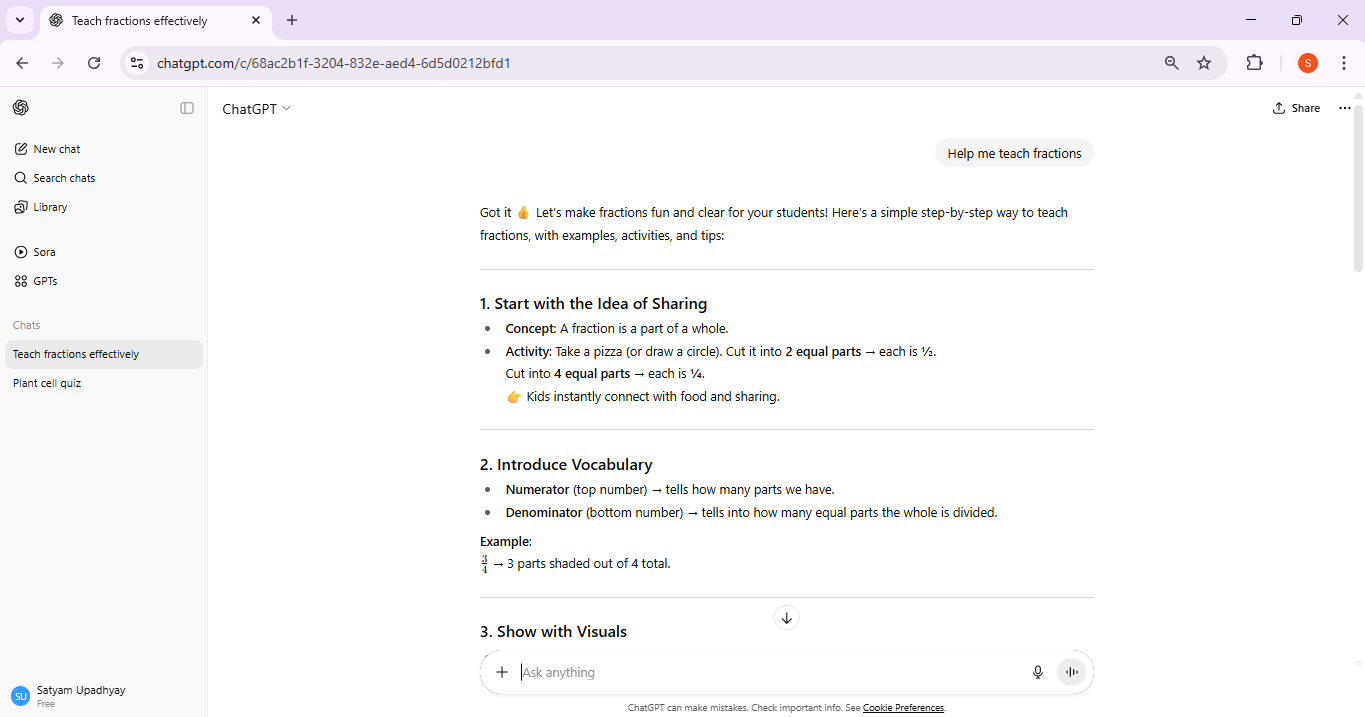
- Strategic: "Design a 30-minute hands-on activity for 4th graders struggling with equivalent fractions using pizza slices and fraction bars. Include a 5-minute warm-up game, group collaboration, and an exit ticket. Three students have IEPs for math, add visual supports and sentence starters".
Result: a ready-to-use activity that fits the classroom, not the internet.
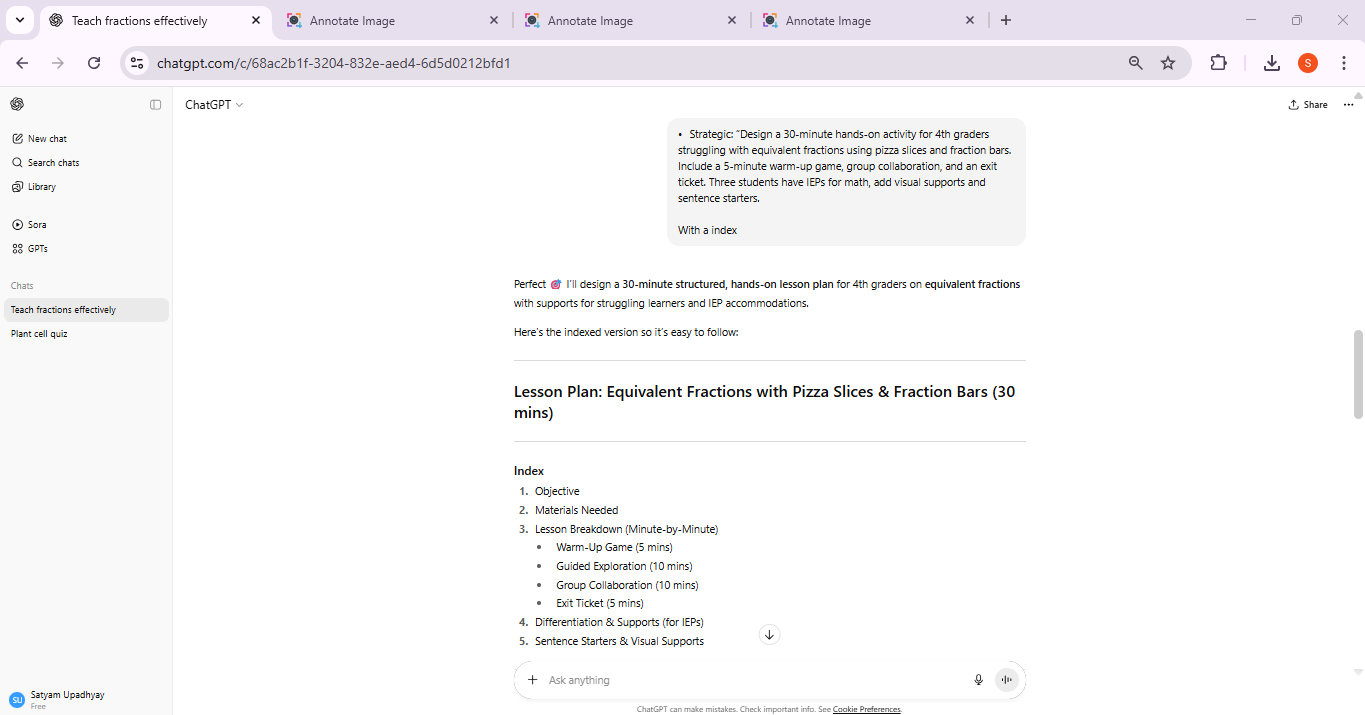
Many educators who have been trained through ABEA's workshops have testified to saving up to 5-7 hours weekly by applying these structured prompt strategies. What you'll learn here comes from real classroom experiments, not just theory.
The "CLEAR" Framework Is All You Need to Remember
After extensive trial and refinement, this simple framework consistently elevates results:
- C - Concise but Complete: "Write a poem about seasons” is vague; "Write a 4-line Hindi poem about monsoon for Class 4" is complete and focused.
- L - Logical Progression: Sequence steps like a mini-lesson plan.
- E - Explicit Expectations: Say "quiz", "rubric", "table", or "visuals" if that's needed.
- A - Adaptive Approach: Expect to refine, ask for version 2 with targeted improvements.
- R - Reflective Review: Fact-check, align to standards, adjust tone, professional judgment stays in charge.
You can save a lot of time by using the CLEAR technique.
Related Read: Want to explore the best AI tools for educators? Check out our detailed guide on the Top 10 AI Tools for Educators and see how these tools are already transforming classrooms.
Here Are The 5 Ingredients of A Killer Prompt
Use this structure for any teaching task:
- Role Assignment: "You are a patient math tutor for 5th graders who struggle with word problems".
- Context Drop: "28 students, 6 are ELL, unit focus: fractions".
- Clear Task: "Create three differentiated activities for mixed-ability groups".
- Format Specifications: "Present activities in a table with estimated timings".
- Constraints and Requirements: "No expensive materials, align to [curriculum standard]".
Copy this mini-template:
"You are [role]. Context: [class, needs, constraints]. Task: [what to produce]. Format: [table or bullets or steps, time-boxed]. Requirements: [materials, tone, reading level, standards]. Ask one clarifying question if critical, otherwise proceed".
Let's have A Look into The Real Prompts That Actually Work
Use these as-is or adapt.
1. Monday Morning Lifesaver (ELA)
"You are a creative 6th-grade ELA teacher. Students just finished a narrative unit but struggle with dialogue punctuation. Create a 15-minute bell ringer using funny Bollywood dialogues. Include 5 practice sentences increasing in difficulty, make it competitive for teams, and provide an answer key with common mistakes explained. Reading level: Grade 6. Format: table with sections: warm-up, practice, team challenge, answers".
2. Differentiation Dynamo (Math)
"Take this word problem: 'Rohan has 24 laddoos to share equally among friends at Diwali'. Create 3 versions:
- Below level: simpler numbers plus visuals
- On level: as is, one step
- Advanced: multi-step division with explanation prompts
Format as a 3-row table (version, problem, scaffold, solution). Include 1 extension question for each".
3. Parent Email Helper
"Draft a supportive email to a parent: their usually A-grade child has dropped to a C due to missing assignments, distractions in class, and a low test score. Tone: empathetic but firm. Goal: partnership and next steps. Limit: 200 words. Include bullet next steps with dates".
4. Quick Exit Ticket (Chemistry)
"You are a chemistry teacher. Create a 10-question exit ticket on balancing chemical equations. Increase difficulty from Q1 to Q10. Provide a clear answer key and one misconception note per question. Format as two sections: 'Student Copy' and 'Teacher Key'".
Step-by-Step Manager: From "Nice Outputs" to "Real Classroom Wins"
Follow this sequence to turn prompts into productivity.
Step 1: Pick One High-Impact Task
Choose a weekly pain point (bell-ringer, quick quiz, parent email, rubric, or exit ticket). Keep scope tight so iteration is fast.
Step 2: Apply CLEAR and the 5 Ingredients
Write the prompt using role, context, task, format, and constraints. Keep it concise but complete.
Step 3: Generate version 1, Then Immediately Tighten
Scan for relevance, reading level, materials, and alignment. Ask for version 2 with targeted edits: "Reduce reading level", "Add bilingual glossary", "Replace materials with printable alternatives", "Convert to 15 minutes".
Step 4: Classroom-Proof It
- Add timing estimates
- Add engagement structures (gamify, peer check, roles)
- Add checks for understanding and an exit ticket
Step 5: Save to Library
Store the final prompt and best version in a sheet (Subject, Grade, Outcome, Prompt, Output link, Status, Notes). This is how time savings compound weekly.
Step 6: Review After Delivery
Note what worked, where students struggled, and what to refine. Update the prompt with these insights. Iteration is the engine of quality.
Following this process ensures prompts don't just generate text; they create measurable outcomes. With repetition, teachers effectively build their own prompt engineering guide customized to their subject, grade level, and student needs.
Are you a teacher looking to upskill?
Bring international pedagogy to your classroom with
Do Not Forget The Common Failures (And Fast Fixes)
- Output too generic? Add student context (ELL, IEPs, class size), constraints (no expensive materials), and explicit format (table, steps, timing).
- Misaligned difficulty? Specify reading level, standard, or item types (recall, application, reasoning).
- Too long? Set hard limits: "15-minute activity," "200 words", "10 questions".
- Inaccuracies? Ask for "sources or curriculum alignment notes", then verify and trim.
- Robotic tone? Specify tone: "warm, student-centered, culturally responsive examples".
Avoiding these pitfalls is something highlighted in structured prompt engineering training, especially for educators balancing limited time.
Then It's The Time for Differentiation in 10 Minutes
Let's be honest, differentiation always sounds harder than it needs to be. But you don’t have to reinvent the wheel for every lesson. Here's a quick pattern that works when time is short:
Instruction (about 5 minutes): Give a short explanation of the topic. A simple sketch on the board or a quick analogy (like “fractions are just pizza slices”) goes a long way.
Three Ways In (10–15 minutes): For students who need more help, add visuals, vocabulary supports, or sentence starters.
For the middle group: Stick with the standard practice task, nice and clear.
For the fast finishers: Give them a twist, something multi-step, or an open question they can explore.
Exit (5 minutes): End with two small questions, one recall, one apply. Nothing fancy, just enough to check if they got it.
If You Want an AI to Draft This for You, You Can Tell It Something like -
"You are a [subject] teacher. Create a 25-minute mini-lesson on [objective] with 3 differentiated paths: Below (with visuals/supports), On (guided practice), Above (extension task). Add a 2-question exit ticket. Put it all in a table with timing, teacher actions, student task, and materials".
This isn't just theory. A lot of professional courses and teacher training programs in India focus heavily on differentiation, but the workload makes it hard to actually do it every day. That's where AI becomes a helpful shortcut instead of another burden.
Assessment and Feedback-Fast and Personalized
- Rubrics: "Generate a 4-level rubric aligned to [standards] for [task], with performance descriptors and common mistakes".
- Feedback banks: "Create 20 reusable feedback comments tagged by criterion and level, student-friendly tone, and one action step each". Quick data view: "Summarize responses into 3 strengths, 3 growth areas, and 3 next steps, with sample re-teach questions".
Communication That Builds Trust
- Parent updates: "Write a 150-word weekly update covering what we learned, one student shout-out (generic), and how to help at home (no-cost ideas). Tone: warm and encouraging".
- Behavior notes: "Draft a neutral, specific incident note with impact and agreed next step. 120 words".
Here too, Prompt Engineering ensures that AI outputs remain practical and aligned with standards.
Make It Stick: Your Reusable Prompt Library
Columns to use:
- Category (Planning, Differentiation, Assessment, Communication)
- Subject and Grade
- Outcome (for example, Exit Ticket: Balancing Equations)
- Prompt (final version)
- Output Link (Doc or Slide or Site)
- Status (Draft, Classroom-tested, Adopted)
- Notes (what to tweak next time)
Tip: Tag repeatables with "weekly staples" such as bell-ringers, exit tickets, and parent updates, so they're easy to reuse with minimal edits.
Over time, your well-built library becomes a personal prompt engineering guide with reusable assets for any teaching task
Try This 7-Day Challenge
Day 1: Build 1 bell-ringer with CLEAR
Day 2: Convert it into 3 differentiated versions
Day 3: Draft a 10-question exit ticket with a misconception note per item
Day 4: Create a rubric plus feedback bank for a short task
Day 5: Draft a 150-word parent update with at-home tips
Day 6: Turn two wins into prompt-library entries
Day 7: Time to look back. Which tasks actually saved you time? Which ones made your class more engaged?
And what can you hand off to ChatGPT next week so you’re not reinventing from scratch again? Reflection is where the real progress shows up.
Let's Have A Few Bonus: Copy-and-Use Prompt Pack
- Standards-Aligned Lesson Brief
"You are a [subject] teacher. Create a 45-minute lesson on [objective], aligned to [standard]. Include: hook (3 min), modeling (7 min), guided practice (10 min), group task (15 min), exit ticket (5 min), materials, and differentiation notes for ELL and IEP students. Output as a table with times". - Retrieval Practice Set
"Generate 10 retrieval questions on [topic]: 3 easy, 4 medium, 3 challenging. Provide an answer key and one misconception note per question. Keep reading level at [grade]". - Re-teach Mini-Plan
"Students scored low on [skill]. Create a 20-minute re-teach with analogy, 5 guided problems, 2 partner problems, and a 2-question exit ticket. Include quick diagnosis prompts for common errors". - Student Feedback Bank
"Write 24 feedback comments for [assignment type], four per criterion across four levels, student-friendly, each ending with a specific next step".
Final Thought
AI won't replace teachers. But teachers who learn to work with AI-clearly, consistently, and reflectively-reclaim time, reduce stress, and create space for creativity again. Start small, build a repeatable library, and let the compounding effect of strong prompts reshape the week. If a ready-to-use Google Sheets or Notion template for the prompt library would help, it can be created and organized by subject, grade, and activity type so this guide becomes plug-and-play for busy schedules.
As AI adoption grows in schools, combining Prompt Engineering skills with existing teacher training in India initiatives can empower educators to lead classrooms more effectively and sustainably.
At ABEA, we constantly help educators adopt AI-driven teaching strategies that blend seamlessly with existing classroom practices. By combining the power of structured prompt engineering with ABEA's teacher training programs , you can unlock higher student engagement and reduce your workload.
FAQ's
Q1. How can teachers use ChatGPT effectively for lesson planning and classroom preparation?
ChatGPT can help teachers generate lesson outlines, hooks, examples, worksheets, and exit tickets based on grade level and learning objectives. When teachers give clear prompts—including context, time duration, and student needs—the output becomes classroom-ready and reduces planning time significantly.
Q2. What is prompt engineering for teachers, and why does it matter?
Prompt engineering is the skill of giving structured, specific instructions to ChatGPT so the output matches classroom needs. Teachers who set a role, define context, specify format, and add constraints get more accurate, relevant, and curriculum-aligned results. It turns ChatGPT from a generic tool into a reliable teaching assistant.
Q3. What are some effective prompts teachers can use for teaching tasks?
High-impact prompts include:
- "Create a 30-minute lesson on - for Grade - with activities and assessments".
- "Generate differentiated tasks for below-level, on-level, and advanced learners".
- "Draft constructive feedback for a student who struggled with"
Specificity in the prompt leads to stronger, more actionable outputs.
Q4. Is it safe and ethical for teachers to use ChatGPT for academic tasks?
Yes, when used responsibly. Teachers should treat ChatGPT as a support system, not a replacement for professional judgment. Avoid entering sensitive student data, always review outputs for accuracy, and maintain transparency in assessments to ensure academic integrity.
Q5. How can teachers use ChatGPT to differentiate learning for mixed-ability classrooms?
ChatGPT can modify reading levels, simplify language, create tiered tasks, add scaffolds, or design enrichment extensions. By specifying learner profiles—ELL, IEP, advanced, struggling—the tool generates variations that make lessons inclusive without increasing planning load.
Q6. Can ChatGPT help teachers provide personalised feedback to students?
Yes. Teachers can paste anonymised student work and request targeted feedback following criteria such as accuracy, clarity, or critical thinking. ChatGPT generates personalised, constructive comments and next steps, helping teachers give meaningful feedback quickly.
Q7. How can teachers use ChatGPT to improve communication with parents and stakeholders?
ChatGPT can draft emails, meeting summaries, progress notes, and classroom updates in a clear, respectful tone. Teachers can adjust the tone—formal, warm, or supportive—ensuring communication remains professional and culturally sensitive.
Q8. What limitations should teachers keep in mind while using ChatGPT?
ChatGPT may occasionally produce inaccuracies, lack real-time data, or over-generalise. Teachers must verify facts, cross-check curriculum alignment, and ensure age-appropriateness. It should support professional decisions, not override them.
Q9. How can teachers combine ChatGPT with traditional pedagogy without compromising teaching quality?
The best approach is hybrid: use ChatGPT for planning, drafting, and ideation, while hands-on teaching, discussion, observation, and relationship-building remain human-led. ChatGPT boosts efficiency; teachers maintain expertise, empathy, and instructional control.
Q10. What is the 30% rule in AI for teachers, and how should it guide classroom usage?
The 30% rule suggests using AI only for initial drafts, ideation, or structuring—not for final decisions or full lesson delivery. Teachers should refine, contextualise, and humanise outputs, ensuring AI supports learning rather than dictating it.
Q11. Can ChatGPT help teachers design assessments, quizzes, and rubrics responsibly?
Yes. Teachers can request grade-appropriate questions, answer keys, competency-based rubrics, and misconception notes. However, they must align outputs with curriculum standards and adjust difficulty to match actual student readiness.
Q12. How can schools help teachers adopt ChatGPT effectively?
Schools can offer training on prompt engineering, AI ethics, and classroom integration. Workshops, guided practice sessions, and peer-sharing circles ensure teachers learn how to use ChatGPT to save time, increase productivity, and strengthen learner support—while maintaining academic integrity.
